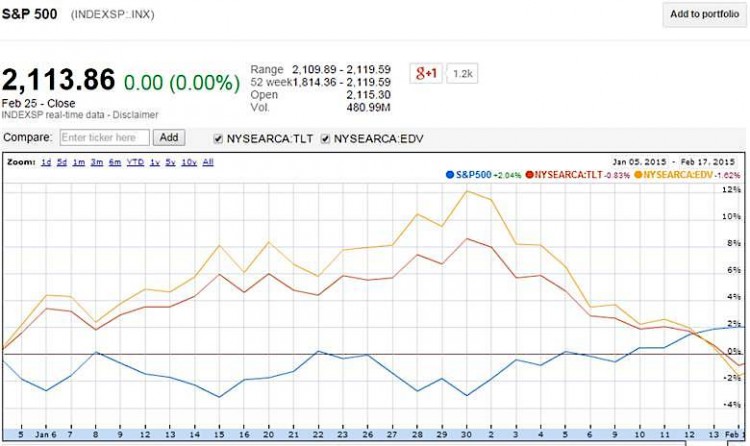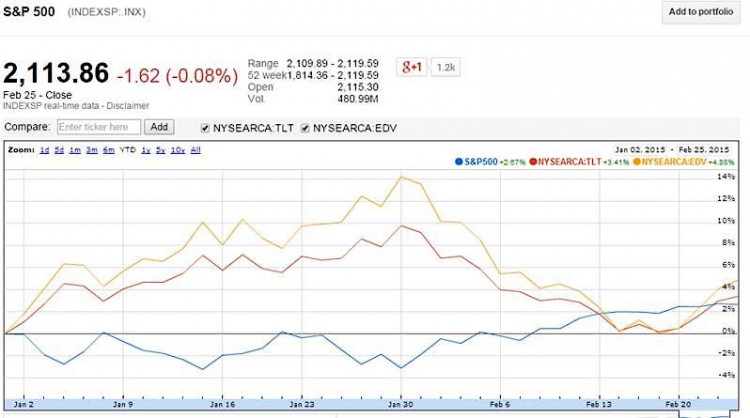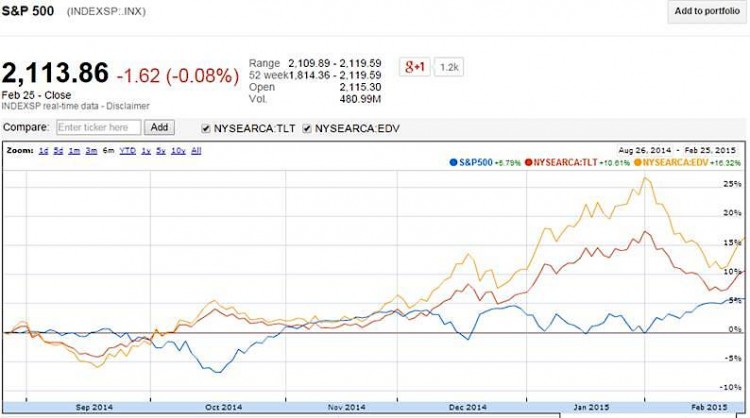Last week, my weekly commentary on the financial markets started with this paragraph:
“The last two weeks the markets have rallied to new all-time highs. At the same time we have seen the yield on 10-year US Treasury bonds increase from a low of 1.6% to 2.15% yesterday. That is a meaningful loss in the bond positions that have been working for the last 3-4 months. “
At that time, stocks had been on a tear and bonds were getting hit hard. Here is what a chart of the S&P 500 compared to the iShares Barclays 20+ Yr Treas.Bond (TLT) and Vanguard Extended Duration (EDV) looked like one week ago:
In last week’s market commentary, I also explained that I believed we were experiencing a counter trend that was temporary and that the longer-term trend of declining bond yields (which results in gains for those owning those bonds) was still intact. That conclusion was based on the fact that worldwide we are still experiencing deflation and that it will continue.
I summarized my views by saying: “I will not be surprised if we see the 10 year UST yield go lower than the 1.6% level it recently hit over the next weeks and months” My conclusion was “although we have seen the U.S. stock markets push back up to their highs and US Treasury bond yields go higher, I strongly believe that it is a counter trend that will not last. Until then, I will remain vigilant and continue to closely monitor the accounts I managed and take action as necessary, first to protect my clients from significant loss and, secondly, to target prudent profits.”
That was not an easy call to make. I had suffered losses because of my decision to continue to hold bonds. Equities were continuing to set all-time highs and it looked like the ‘safe’ bet was in equities. The bottom line, though, is that to reverse that decision would have meant selling at what could ultimately be the lows of the bond counter trend. So I could have lost twice.
As expected, the economic data and the Federal Reserve minutes confirmed that the U.S. economy is slowing, that inflation is not a threat and that they will remain ‘patient’ in raising interest rates. In other words, it is highly unlikely that the Fed will raise interest rates any time in 2015. As a result, the trend of declining interest rate yields on the 10-year US Treasury bond continues to show signs of being in tact. Take a look at this chart and you can see the difference a few days/weeks makes:
We have not fully recovered yet. The yield on the 10-year UST has declined from 2.16% to 1.97% (as of February 25). Vanguard Extended Duration (EDV) is up 3.59% in the last 5 days compared to the S&P 500 index only being up 0.68% (again through February 25). As you see in the chart above, bonds are again out-performing the S&P 500 on a year-to-date basis.
Here is an updated chart comparing bonds to the S&P 500 index going back to last September:
This trend is not over and until economic data shows signs of life and activity picks up, it is likely that bond yields will continue to trend lower – perhaps for many more weeks and months. How much lower can they go? Consider this—Germany is one of the strongest economies in Europe right now and their 10-year Bund yield just dropped to an all-time low of 0.29%. The Japanese 10-year bond is at 0.33%. Granted, our economy is significantly larger and stronger than either of those countries and I don’t expect our 10-year US Treasury bond to get that low, but it does indicate that it can go much lower from where it is now.
That doesn’t mean that bonds are the only game in town, they aren’t. I have added around 40 equity positions to client accounts so far this year and I am eager to add more on market pullbacks. The key to surviving and thriving in these highly manipulated markets is flexibility. My allegiance isn’t to any specific investment; my allegiance is to protecting wealth from a significant loss while pursuing prudent profits. Thanks for reading.
Follow Jeff on Twitter: @JeffVoudrie
Author has positions in mentioned securities at the time of publication. Any opinions expressed herein are solely those of the author, and do not in any way represent the views or opinions of any other person or entity.










